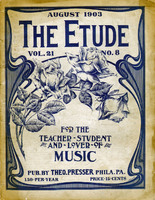We have noticed in the columns of this department several pleas for more variety and interest in the programs of organ recitals. Organists will do well to heed these suggestions and apply them not only to their recital programs, but also to their anthem selections for church service. Possibly it may be a reaction from the weak and saccharine effusions offered some years ago by the all-prevalent quartet choir, but it is a fact that present-day programs contain much material that is a bore to the average congregation, however much its preparation may have interested the organist and singers.
American organists and choirmasters apparently do not realize that the Anglican—more especially the cathedral—style of anthem does not, as a rule, possess the qualities likely to prove of interest to the general run of the church-goers of this country. Many English anthems seem to be constructed on the principle that all that is necessary in the composition of an anthem is to select a text and set to it smooth and correct succession of harmonies with an occasional dash of counterpoint. That will not answer on this side of the water.
The average non-professional American listener of either cultivated or uncultivated musical taste seeks for well-defined melody and for certain rhythmic qualities. This applies to church music as well as to all other sorts. The great success and perennial popularity of certain American anthems proves it. In our admiration for the good qualities of these compositions we are not blind to their weak points, but we perceive in the work of our American church composers a decidedly upward tendency, an effort to improve the quality of their work while retaining its interest and attractiveness, which is altogether praiseworthy.
We have said that the American anthem to prove attractive must have a well-defined melody. Preferably this melody should appear in the treble, the remaining voices adding rich and interesting, but not complicated, harmonies. An occasional unison passage approaching to a climax is effective, but such passages should not be overdone. Modern part-writing, on a harmonic basis, may be employed to enhance the general effect where it does not obscure the melodic idea. Above all things, the ideal American anthem must convey the idea of motion. To this end the rhythmic effects must be striking and of well- sustained interest. If these points were more often borne in mind by organists and choirmasters in the compilation of their service lists an appreciable increase of interest in the church music on the part of the average congregation would immediately ensue.
Organists and singers must bear in mind that they are placed in choir galleries, not for their own edification, but to lead the congregation, adding beauty and interest to the worshipful portion of the church service. That the musical taste of a congregation may be gradually elevated is unquestioned; but this may not be done by beginning at the wrong end.— Preston Ware Orem.



